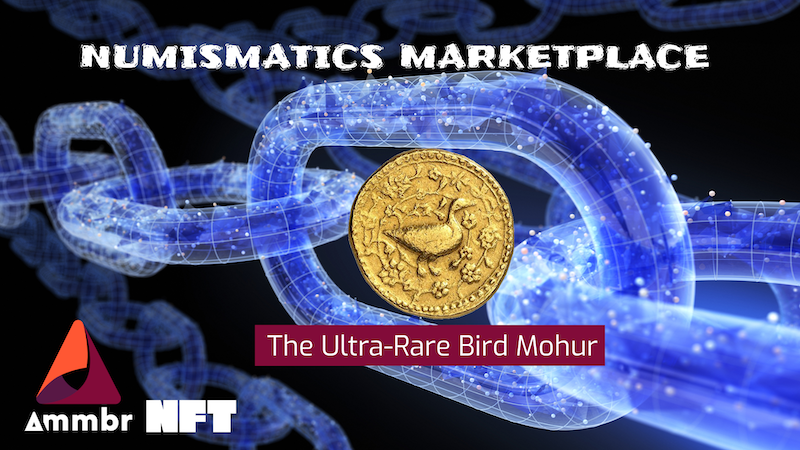Abu Dhabi, United Arab Emirates, October 4, 2021 – /ExPressRelease UK/- Ammbr is pleased to announce the listing by NFT auction a numismatic rarity a revolution in Islamic coinage, the “Bird Mohur” from the reign of Jalal-al-din Muhammad Akbar, perhaps the most enlightened of the Mughal (or “Moghul”) Empire. This particular coin is a fine example and one of only two known specimens. Any serious numismatist, with the budget to allow them, would be proud to add this coin to their collection.
The current owner of the Bird Mohur, a private collector, has been in talks with Ammbr’s Director of Procurement, Sunil Bumb, for some months, tracking the spectacular growth of the sale of artwork using NFT.

Says Mr. Bumb, “Through experimentation with the Ammbr team, the owner of this spectacular coin, perhaps the best in his collection, is now convinced of the tremendous opportunities in NFT technology and the approach we at Ammbr are taking to the legal framework supporting the decentralised trade in NFT. As an early Ammbr Platform verified account holder, he is considering tokenisation of a large part of his collection as the numismatics market moves into the exciting world of tokenised trading.”
Chief Strategy Officer at Ammbr, Rakesh Rajagopal explains the significance of this listing. “We see a kindred spirit to Blockchain in the enlightened spirit of Jalal-al-din Muhammad Akbar and his acumen in applying innovation to stimulate and foster an empire, an economic marvel of diversity and sustainability in its day. Ruling an empire with a great diversity of faiths, languages, and cultures, Akbar was remarkably tolerant and took elements drawn from Islam, Hinduism, Zoroastrianism as well as from Christianity, Jainism, and Buddhism and eventually bringing his own Syncretic religion called Dīn-i-Ilāhī.”
The listing of the Bird Mohur is a coup for Ammbr. Akbar issued very rare gold multiples of 100, 50, 20, 20, 5, and 2 mohurs as presentation pieces or diplomatic gifts. Few survive to this day, and none have appeared on the market in recent years.”
Collectors who wish to place a bid for the Bird Mohur may do so at the Ammbr NFT Auction site. Bids start at 688,001 BUSD – https://nft.ammbr.finance/nft/18
The Ammbr NFT Platform offers a highly secure sales and auction channel, supported by seller agreements that ensure strong anti-money laundering and commercially sound practices that match the fast and frictionless trade that typifies the technology. A wide range of valuable goods is targeted for listing on the Ammbr Platform, including numismatics, gems, jewellery, watches, stamps, antiques, and artwork.
About the Ammbr NFT Marketplace
Ammbr is an Abu Dhabi based decentralised technology company that develops and operates one of the leading platforms that will forever change the way creative artists, celebrities, and collectors conceive of ownership and the trading of intellectual property and valuable goods. Such ownership can now be not only outright but also fractional, lowering the bar to access, achieve affordability for everyone. By diminishing opacity in favour of transparency of information NFT technology will modernise and democratise an industry that has largely been shrouded in secrecy and only available to the well-heeled operating in the rarefied atmosphere of exclusive investor circles.
Background of the Auction Item
The Mughal (or “Moghul“) Empire ruled much of South Asia for over three centuries. Mughal emperors accumulated vast wealth, with an economy based on a stable and abundant coinage in gold, silver and copper. They commissioned magnificent buildings and works of art – including some of the largest, costliest, most beautiful and most historic coins ever issued.
Jalal-al-din Muhammad Akbar was just 14 years old when he came to the throne. His guardian, Bairam Khan, commander of the Mughal army, served as regent until Akbar came of age. Lavishly equipped with artillery and matchlock muskets, Akbar’s army conquered much of the South Asian subcontinent during a reign of almost 50 years.
Ruling his empire with its enormous diversity of faiths, languages and cultures, Akbar was remarkably tolerant, eventually abandoning orthodox Islam as the state religion. The Bird Mohur features several of Akbar’s innovations to the coinage. The first is its weight. Akbar introduced the Mohur as the standard weight for his gold coinage at around 11 grams. He then initiated his own dating system, the Din-i-Ilahi (literally Faith of God). This calendar incorporated elements of the different religious beliefs in his empire. The Ilahi calendar was solar, divided into twelve months, rather than the lunar Hijri calendar. Months bore the same names as those of the Persian kings, corresponding to the feasts of the Zoroastrians. The first Ilahi year was that of Akbar’s accession in AH 963. On coins, beginning in 1584, he recorded the date in terms of his regnal year rather than the Islamic calendar, and he replaced the Shahada (Muslim profession of faith) with an Arabic phrase most religions could accept: “God is great, glorified be His glory” (Allah akbar, jalla jalalahu). He abolished the discriminatory tax imposed on non-Muslims, and welcomed scholars, clerics, artists and poets of many religions and cultures to his court.
Some of Akbar’s late coins ignore the Islamic prohibition on artistic depiction of living creatures: the specific item listed on the Ammbr NFT Auction depicts very rare mohur shows what is often described as a duck, but is likely a royal game bird, the hubayra, surrounded by a rich floral pattern.
Akbar died on October 27, 1605. His tomb at Agra, built by his son Jahangir, is a masterpiece of Mughal architecture. The British Museum catalogue of Mughal coins succinctly explains why Akbar deserved the epithet “Great”:
“The proof of the soundness of his system is the continuance of the Moghul Empire after his death, in spite of the follies and vices of his successors.”






